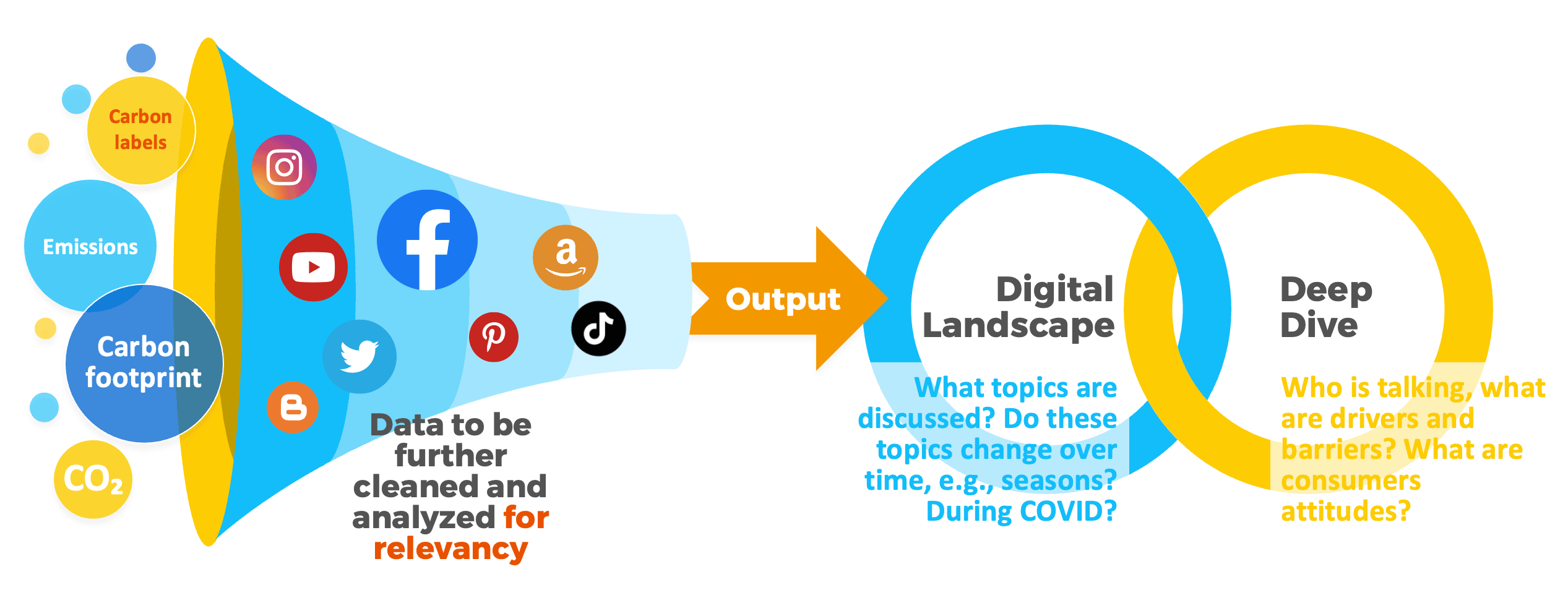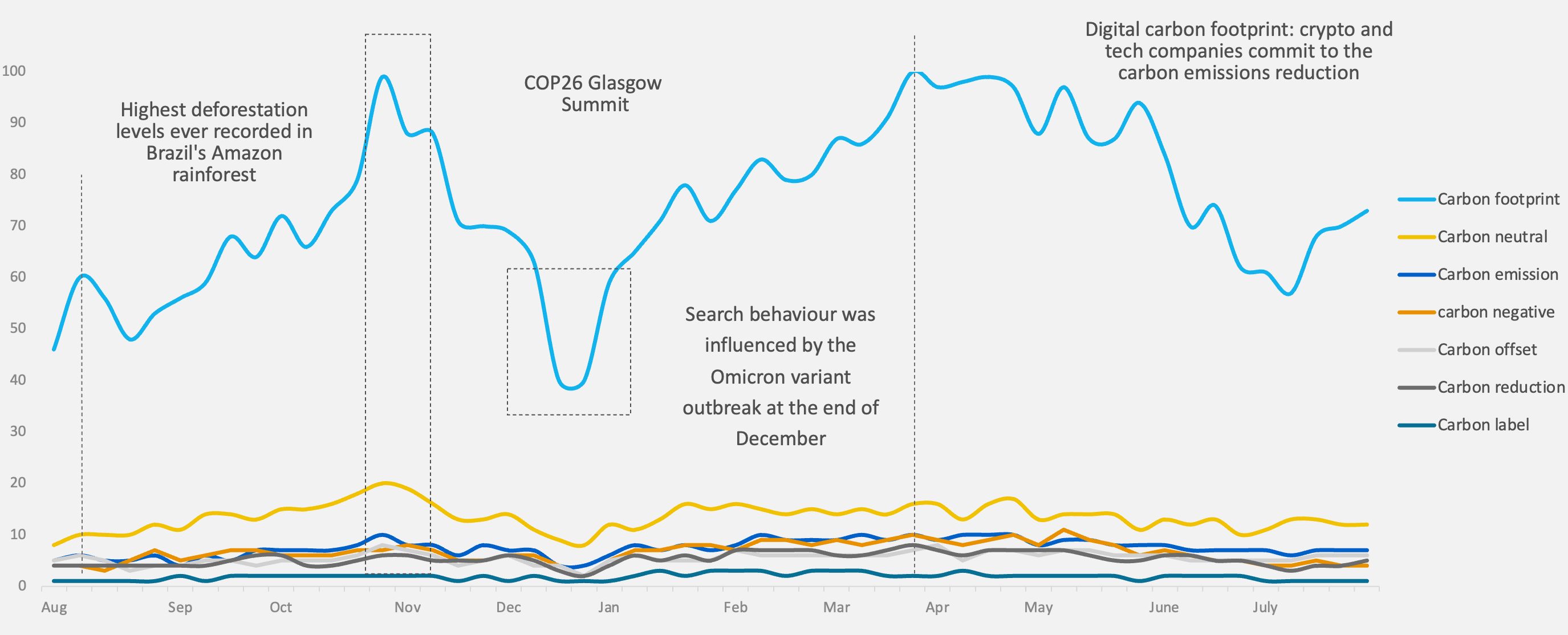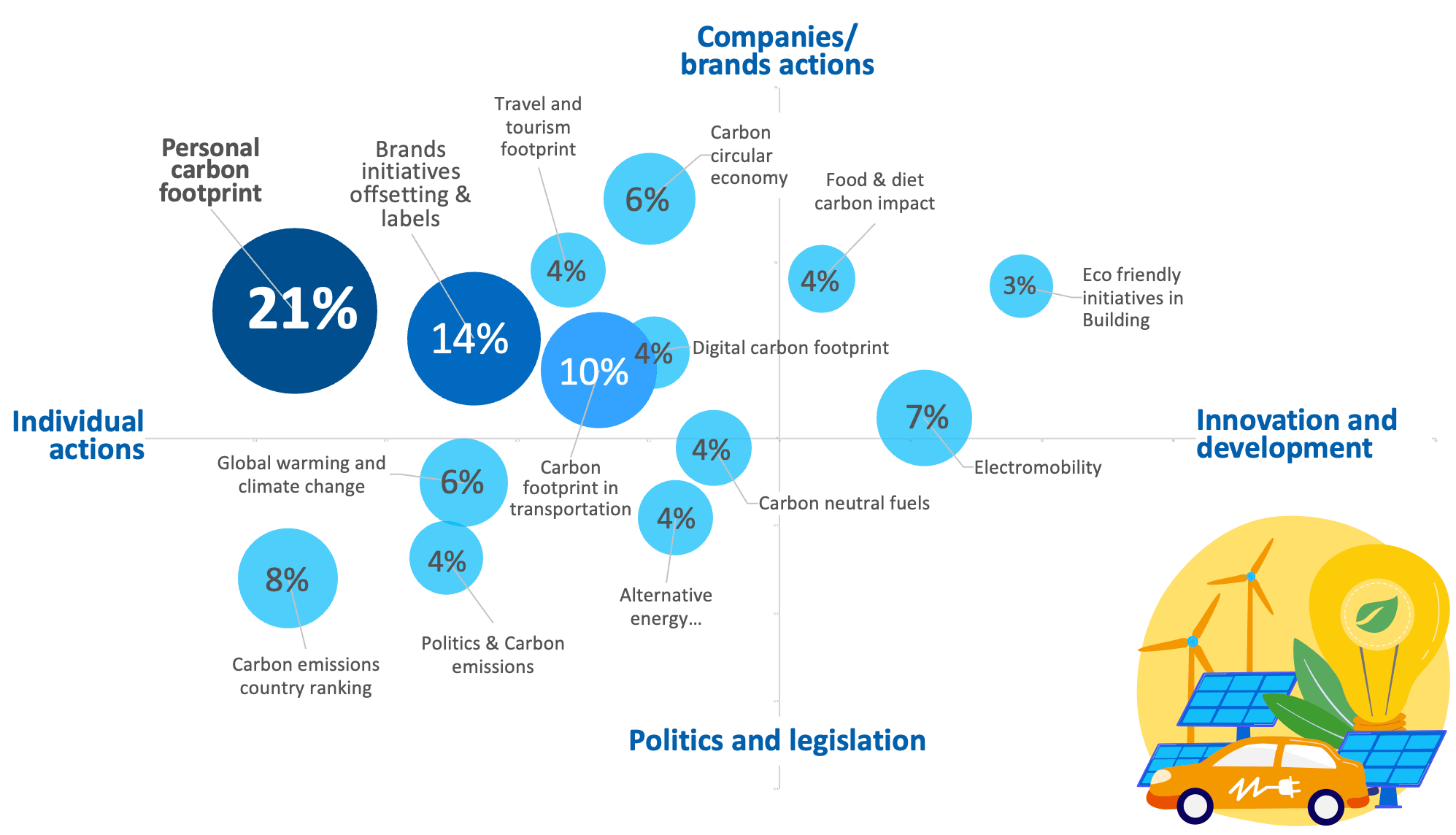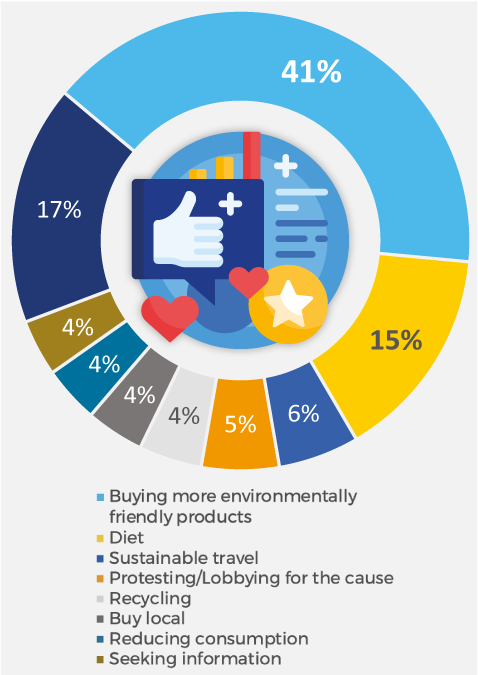It’s not easy being green
How brands can
drive consumer engagement
A deep understanding of consumers’ climate conversations
Using AI modeling and human enrichment, we examined:
- Unmet needs and wants, frustrations, delights
- Impact on consumer behaviors
- Consumer feelings

How much do consumers care about climate change?
First, it’s important to know that consumer interest in the environment has been significantly increasing in recent years. Studies have found that people are also more open to making lifestyle choices that are more environmentally sustainable. 73% of consumers globally say they’ll change their consumption habits. More than 2/3 claim they’re already doing all they can to protect the environment.
Moreover, as the environment and climate change increasingly makes headlines, consumer interest surges. For example, the COP26 Glasgow Summit resulted in a spike in online search activity related to carbon footprint and carbon neutral.
To put the rising importance of this topic into perspective, the volume of user generated content about carbon emissions is now nearly equal to fashion. The number of raw conversations on carbon emissions increased by 38% in just one year.
Changing search behaviors are clearly connected to newsworthy environmental events – a useful insight for the timing of any related messaging.
Online search behaviours – Indexed volume per topic (global)*

*popularity of top search queries in Google Search from August 2021 to July 2022
What are the best channels for climate communication?
When consumers discuss carbon emissions and sustainability on social media they’re usually posting to Instagram and Twitter. Instagram is the leading platform for brands to initiate dialogue with people in this space. Twitter and YouTube prompt more spontaneous reactions. Consumers generally take the lead in discussions. Therefore, the social channel you use should reflect your communication goals of course.
- Instagram and Facebook are better for low-involvement content, such as brand messaging or introducing new products.
- YouTube is ideal for educating consumers and trying to influence change since it facilitates layered messaging with long video content.
Knowing when people talk, and what people are talking about could help you target your message on specific channels.
What motivates and deters consumers’ climate actions?
In the digital landscape, we leverage AI to cluster all the conversations about carbon emission and sustainability. Personal carbon footprint is the topic that stands out in terms of volume, followed by brand initiatives. These topics come up close to each other for a reason. Brand initiatives stimulate consumers to make changes in their consumption habits and people discuss their initiatives in their own actions.
Conversations about consumer and company actions are very closely related to each other. Consumers demand companies to take action when it comes to emission production. At the same time, companies need people to be engaged with their actions for the initiatives to be successful.
We also analyze the data using human enrichment to more accurately determine consumer sentiment. For example, although carbon footprint is the term consumers use most frequently, their reactions are less positive. On the other hand, carbon reduction and carbon negative sparked more positivity in conversations. Our research found consumers tend to associate the phrase “saving the planet” with greenwashing when it’s used non-specifically and as a broad concept.
Volume per topic in online conversations

N ~1 MM online conversations
Price was not mentioned by consumers as a barrier to reducing carbon emissions.
However, we see other studies indicating that price is a barrier to purchase.

Consumers talk a lot online about their individual actions to reduce their carbon footprint. This behavior is driven by their desire to make a positive impact on the environment. They feel it’s their individual responsibility. We see consumers already focusing on sustainability in their purchases:
- Buying products with sustainably-sourced raw materials
- Choosing packaging with little or no plastic
- Eating less meat and meat substitutes
On the other hand, some consumers think their personal actions are too small to make an impact. These skeptical consumers tend to be male and are very vocal about the lack of credibility of climate initiatives. Their responses include:
- Climate communication from companies is greenwashing
- Brands are not taking enough responsibility and not transparent in climate initiatives
- Climate information from brands is a marketing strategy or marketing ploy
Behaviour – Positive
 Behaviour – Positive sentiment, N = 873
Behaviour – Positive sentiment, N = 873
Barrier differences between sectors
In beauty and personal care, greenwashing is a major deterrent to consumer change.
On the other hand, greenwashing doesn’t affect consumers as much in the transportation industry. So, it’s important to customize climate communication strategies by sector.
How different consumers perceive climate communications
Age doesn’t discriminate.
Younger generations are more active online but all age groups communicate about environmental topics with a similar level of urgency. Recent studies show that older consumers are only a bit behind in terms of engagement and they’re just as interested as younger consumers. Older consumers also react as positively as the younger generation.
Brands should target all age groups when communicating about climate initiatives.
Targeting climate communications by consumer groups
We identified four main types of consumers, based on how they discussed and reacted to environmental topics.
Improvers: The largest group (74%) among the consumers. They are vocal online about climate change, often refer to scientific sources, and share actions to reduce their carbon footprint.
Unsurprisingly, they are highly aware of carbon labeling and care the most about the topic.
Doubters: These consumers may care about carbon emissions but are less aware of carbon labels.
Although vocal online, they are less positive in the carbon footprint debate. They are open to making more sustainable choices but lack understanding and tend to question information.
Non-believers: The most skeptical consumer group.
They do not care about their carbon footprint and find carbon labels misleading. They are least receptive to climate communication although they may be persuaded by relevant influencers.
Not committed: They don’t care about their carbon footprint and are poorly informed on the topic.
It’s unlikely that information on carbon labels will influence these consumers.
What climate actions do consumers expect from brands?
Above all, consumers feel that brands should take the lead and do more to cut carbon emissions. They’re looking for honest communication from brands about their sustainability initiatives and impact.
Consumers perceive carbon labeling and carbon offsetting as effective tools to help reduce or compensate for personal carbon footprints. We also gathered insights on how consumers think brands can make these initiatives more effective.
Consumers say carbon labels are not consistent or easily comparable. As a result, it’s difficult to use the information when making purchasing decisions. They doubt the accuracy of carbon labels because there are so many different kinds. Some would like to see a simplified color code, such as the one found in nutrition labels.
Carbon offsetting also has an overall positive perception. Consumers who view it negatively say offsetting only alleviates consumer guilt and isn’t a true climate solution. Some feel their individual offsetting contribution won’t really help.
Best practices for effective carbon labeling and offsetting
Creating the carbon label
- Be transparent and accurate about calculations. Account for the entire product lifecycle, from sourcing to production to waste. Use internationally recognized standards.
- Aim for consistency and design simplicity. Use cohesive information that enables comparability between labels. Consider how much information is already displayed. Are consumers able to calculate their own footprint? Will a color scheme add clarity?
Developing carbon offsetting options
- Choose a reliable, recognized and transparent program. Use a company credited by the Gold Standard that has multiple types of compensation projects in different regions. The partner should show where each consumer’s individual contribution has made a difference.
- Ensure consumers can get accurate program information. Add scannable labels on your packaging or links on your website that direct consumers to your carbon offset partner.
Key insights for engaging consumers in sustainability initiatives
Fast-growing interest
Consumers are engaging online with topics related to environmental sustainability and climate change. Most conversations come from consumers discussing their individual carbon footprint (21%) and notable brand initiatives (14%) to reduce emissions. More than 88% of these discussions take place on social media while 8% happened on forums.
Clear consumer profiles
Online consumers can be classified according to their attitude to the subject. Improvers, the largest group, have already made changes in their daily lives and are open to further reducing their emissions. Consumers from all age groups are committed to reducing their carbon footprint but men are considerably more skeptical than women.
Shifting behaviors
Being part of the solution and the proven effectiveness of the measures taken are the main drivers to reduce emissions. There are already visible behavioral changes that consumers have made among all age groups such as buying more environmentally friendly products (41%), dieting (15%) or choosing sustainable travel (6%).
Actionable strategies and barriers
Consumers increasingly feel it is their individual responsibility to reduce their carbon emissions. The most frequently mentioned barriers come from consumers who think that their own actions will not make a difference (22%). The skepticism is driven by lack of credibility (12%) of the initiatives proposed to reduce emissions, often seen as greenwashing (8%). To a lesser extent, brands are blamed for not being transparent or held accountable for their operations.
Recommendations for improving sustainability communications
Practice what you preach: Gain credibility with consumers by being transparent about the brand’s own ESG efforts and commitment to sustainable production. Demonstrate how the brand lives its values. Otherwise, consumers may perceive your environmental communications (especially carbon labeling) as greenwashing.
- Conduct an environmental review of all brand activities, set targets for improvement and implement an action plan. Share detailed strategies and honest results.
- Offer a carbon offsetting program that’s reliable, transparent and easy to use. Clearly indicate how purchases can directly impact carbon reduction.
- Make your brand as accountable as consumers for environmental impact.

Reconsider your targeting strategy: Communicate with all age groups. Remember that men tend to be less “supportive” of the issues surrounding carbon footprint.
- Prioritize improvers by reinforcing their good intentions.
- Try to educate doubters and build trust among non-believers.
All brand content needs to be easy to understand, relatable to the brand and evidenced in what you are doing to meet those claims. Any visual representation (or association with the implications of that visual) should be carefully balanced and factually supported.
Authors
Jon Arthurs
Global Head of Sustainability Practice at MetrixLab
Gilbert Saktoe
Global Lead of Social Insights at MetrixLab
Want to know more?
About MetrixLab
MetrixLab provides consumer insights that drive smarter business decisions. A truly global digital research agency, we pioneer new technologies and integrate multiple data sources to push the boundaries of research. This enables our experts to provide high-quality insights at scale, at speed and for an unparalleled value. Our passion, expertise, and solutions enable our clients to succeed at product innovation, brand engagement, and consumer value.
Active in over 90 countries, MetrixLab is a proud partner of more than half of the world’s top 100 brands and part of Toluna.
About the authors
Jon Arthurs leads the Global Sustainability practice at MetrixLab and has been in MetrixLab for 8 years with over 25 years industry experience gained in both Client-side roles and Consulting roles. Jon is passionate about developing products, brands and communications for the good of people, planet and profit. A strong believer in creating strategies to grow business that doesn’t harm society, community and the environment through a pragmatic lens.
Gilbert Saktoe leads the Global Social Insights team at MetrixLab. Gilbert is passionate about creating insights from digital consumer behavior and has helped to grow some of the biggest and most exciting brands in the world. He is an advocate of using a scientific method to answer business questions and to challenge the status quo of insights.
MetrixLab operates a Social Insights Privacy Policy, which takes into account the privacy of people publishing content online.

